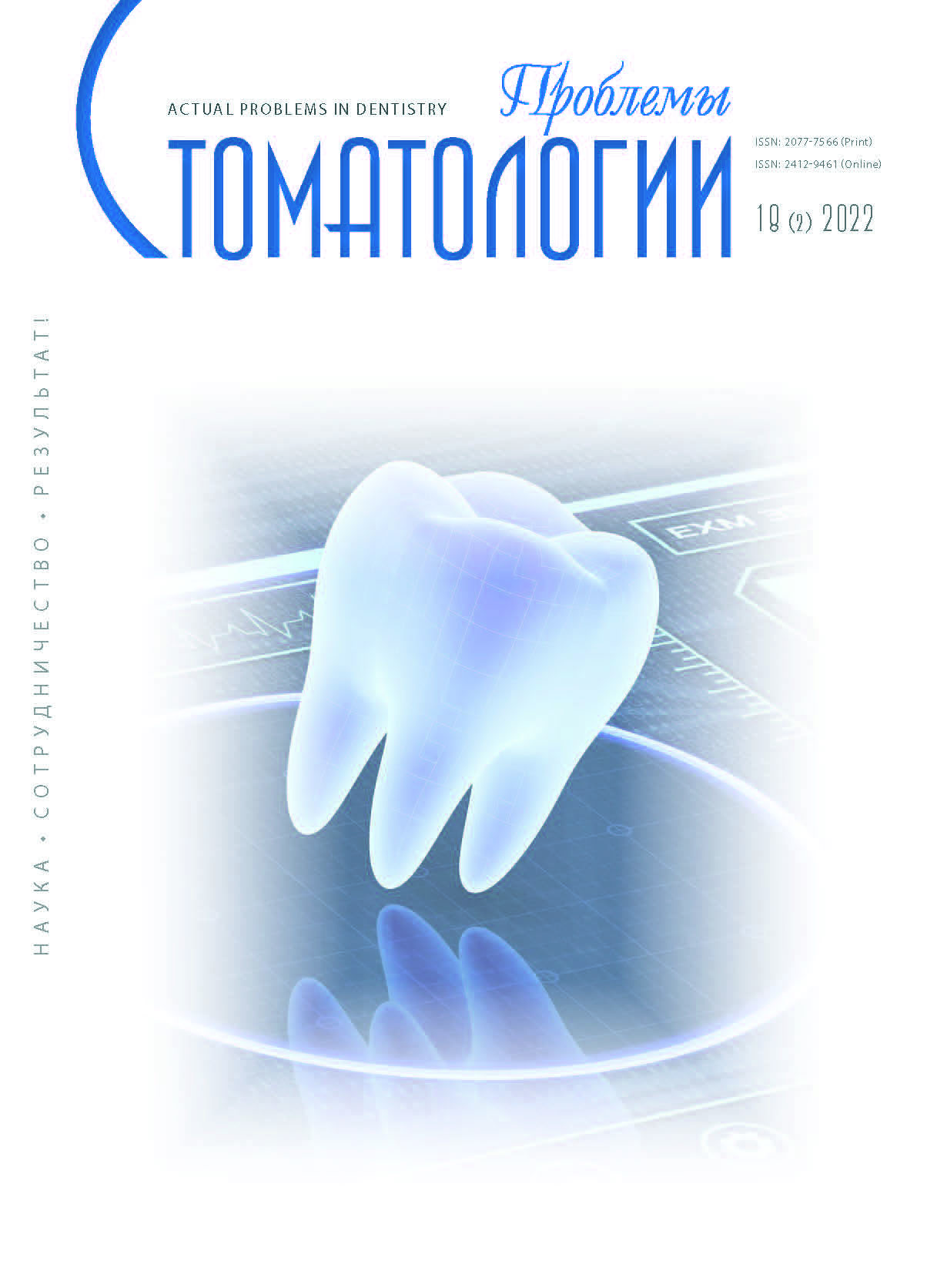Ekaterinburg, Ekaterinburg, Russian Federation
Yekaterinburg, Ekaterinburg, Russian Federation
Ekaterinburg, Ekaterinburg, Russian Federation
Ekaterinburg, Russian Federation
Yekaterinburg, Ekaterinburg, Russian Federation
Ekaterinburg, Russian Federation
Ekaterinburg, Ekaterinburg, Russian Federation
Ekaterinburg, Ekaterinburg, Russian Federation
Ekaterinburg, Ekaterinburg, Russian Federation
Subject. Clinical and cytological manifestations of a new coronavirus infection in the oral cavity. Objectives. Identification, description and systematization of the main clinical and laboratory manifestations of a new coronavirus infection in the oral cavity in older patients. Methodology. The clinical study involved 50 elderly (60–74 years old) and senile (75–90 years old) patients who visited a dentist after an infection from September 2020 to February 2022. Study group 1 included patients with dystrophic syndrome, study group 2 – with inflammatory periodontal syndrome, study group 3 – with occlusive syndrome. Patients underwent dental and general clinical examination. The cytological study included an assessment of the cytoplasmic and karyological abnormalities level, calculating the integral indices of the buccal cytogram. Results. Most often, dental manifestations of a new coronavirus infection occur in older patients. All manifestations in the oral cavity are nonspecific, and the pathognomonic syndrome has not been established. The most common clinical manifestations are candidiasis, exacerbation of chronic periodontitis, exacerbation of herpes infection, etc. The cytological changes in the buccal epithelium reflect a general trend towards an increase in degenerative-dystrophic changes in cells, the predominance of apoptosis processes. Conclusion. Patients with dystrophic syndrome showed the greatest polymorphism of clinical manifestations associated with a new coronavirus infection (candidiasis in 59%, exacerbation of herpes infection in 47% of patients). In patients with inflammatory periodontal syndrome, exacerbation of chronic periodontitis was noted in 100% of cases. In patients with occlusive syndrome, there is an aggravation of the teeth hyperesthesia. Analysis of the integral indices of the buccal cytogram showed signs of accumulation of cytogenetic disorders after the infection.
new coronavirus infection, age-associated dental syndromes, buccal epithelium, cytological examination, older patients
1. Bordea I.R., Xhajanka E., Candrea S., Bran S., Onișor F., Inchingolo A.D., Malcangi G., Pham V.H., Inchingolo A.M., Scarano A., Lorusso F., Isacco C.G., Aityan S.K., Ballini A., Dipalma G., Inchingolo F. Coronavirus (SARS-CoV-2) Pandemic: Future Challenges for Dental Practitioners // Microorganisms. - 2020;8(11):1704. Doi:https://doi.org/10.3390/microorganisms8111704
2. Aleksova A., Gagno G., Sinagra G., Beltrami A.P., Janjusevic M., Ippolito G., Zumla A., Fluca A.L., Ferro F. Effects of SARS-CoV-2 on Cardiovascular System: The Dual Role of Angiotensin-Converting Enzyme 2 (ACE2) as the Virus Receptor and Homeostasis Regulator-Review // Int. J. Mol. Sci. - 2021;22:4526. Doi:https://doi.org/10.3390/ijms22094526
3. Park G.C., Bang S.Y., Lee H.W., Choi K.U., Kim J.M., Shin S.C., Cheon Y.I., Sung E.S., Lee M., Lee J.C., Kim H.S., Lee B.J. ACE2 and TMPRSS2 immunolocalization and oral manifestations of COVID-19 // Oral Dis. - 2022;9. Doi:https://doi.org/10.1111/odi.14126
4. Chubarnova M.V., Davydov A.B., Esin V.A., Davydova O.B., Kostin I.O. Izmeneniya mikrocirkulyacii slizistoĭ obolochki polosti rta u pacientov, perenesshih COVID-19 i ne poluchayuschih antikoagulyantnuyu terapiyu. Regionarnoe krovoobraschenie i mikrocirkulyaciya. 2021;20(4):95-100. [M.V. Chubarnova, A.B. Davydov, V.A. Esin, O.B. Davydova, I.O. Kostin. Changes in the microcirculation of the oral mucosa in patients who have undergone COVID-19 and are not receiving anticoagulant therapy. Regional circulation and microcirculation. 2021;20(4):95-100. (In Russ.)]. Doi:https://doi.org/10.24884/1682-6655-2021-20-4-95-100
5. Modina T.N., Cinekker D.T., Haritonova M.A. i dr. SARS-Cov-2 v polosti rta i obostrenie hronicheskoy parodontal'noy patologii u pacientov s novoy koronavirusnoy infekciey (COVID-19). Problemy stomatologii. 2021;17(1):70-75. [T.N. Modina, D.T. Zinekker, M.A. Kharitonova. SARS-Cov-2 in the oral cavity and exacerbation of chronic periodontal disease in patients with new coronavirus infection (COVID-19). Actual problems in dentistry. 2021;17(1):70-75. (In Russ.)]. https://www.elibrary.ru/item.asp?id=45699798
6. Gherlone E.F., Polizzi E., Tetè G., De Lorenzo R., Magnaghi C., Rovere Querini P., Ciceri F. Frequent and Persistent Salivary Gland Ectasia and Oral Disease After COVID-19 // Journal of Dental Research. - 2021;100(5):464-471. Doi:https://doi.org/10.1177/0022034521997112
7. Huang Ni, Pérez Paola, Kato Takafumi, Mikami Yu, Okuda Kenichi, Gilmore Rodney C. SARS-CoV-2 infection of the oral cavity and saliva // Nat Med. - 2021;27(5):892-903. Doihttps://doi.org/10.1038/s41591-021-01296-8
8. dos Santos J.A., Normando A.G.C., Carvalho da Silva R.L., Monteiro de Paula R., Cembranel A.C., Santos-Silva A.R., Silva Guerra E.N. Oral mucosal lesions in a COVID-19 patient: New signs or secondary manifestations? // International Journal of Infectious Diseases. - 2020;97:326-328. Doi: https://doi.org/10.1016/j.ijid.2020.06.012
9. Burton M.J., Clarkson J.E., Goulao B., Glenny A.M., McBain A.J., Schilder A.G.M., Webster K.E., Worthington H.V. Antimicrobial mouthwashes (gargling) and nasal sprays administered to patients with suspected or confirmed COVID-19 infection to improve patient outcomes and to protect healthcare workers treating them // Cochrane Database of Systematic Reviews. - 2020;9;CD013627. Doi:https://doi.org/10.1002/14651858.CD013627.pub2
10. Derruau S., Bouchet J., Nassif A., Baudet A., Yasukawa K., Lorimier S., Prêcheur I., Bloch-Zupan A., Pellat B., Chardin H. et al. COVID-19 and Dentistry in 72 Questions: An Overview of the Literature // J. Clin. Med. - 2021;10:779. Doi: 10.3390/ jcm10040779
11. Gil'miyarova F.N., Gusyakova O.A., Konstantinov D.Yu., Selezneva I.A., Borodina I.A., Kolot'eva N.A., Konstantinova E.A., Tlustenko V.S., Lebedeva S.S., Temnik E.I., Remizov V.V Molekulyarnyy profil' rotovy zhidkosti pri novoy koronavirusnoy infekcii. Klinicheskaya laboratornaya diagnostika. 2021;66(3):133-138. [F.N. Gilmiyarova, O.A. Gusyakova, O.A. Konstantinov, I.A. Selezneva, I.A. Borodina, N.A. Kolotyeva, E.A. Konstantinova, V.S. Tlustenko, S.S. Lebedeva, E.I. Temnik, V.V. Remizov. Molecular profile of the oral fluid in a new coronavirus infection. Clinical laboratory diagnostics. 2021;66(3):133-138. (In Russ.)]. https://www.elibrary.ru/item.asp?id=44890262
12. Pinto T.G., Alpire M.E.S., Ribeiro D.A. Cytogenetic Biomonitoring in Buccal Mucosa Cells of COVID-19 Patients: Preliminary Findings // In Vivo. - 2021;35(6):3495-3499. Doihttps://doi.org/10.21873/invivo.12651
13. Semencova E.A., Bazarnyy V.V., Mandra Yu.V., Polushina L.G., Svetlakova E.N. Vliyanie vozrasta na parodontal'noe zdorov'e cheloveka. Problemy stomatologii. 2020;16(3):30-36. [E.A. Sementsova, V.V. Bazarny, Yu.V. Mandra, L.G. Polushina, E.N. Svetlakova. Influence of age on periodontal health. Actual problems in dentistry. 2020;16(3):30-36. (In Russ.)]. https://www.elibrary.ru/item.asp?id=44153720
14. Semencova E.A., Mandra Yu.V., Bazarnyy V.V., Polushina L.G., Grigor'ev S.S., Elovikova T.M., Svetlakova E.N., Zhegalina N.M. Vzaimosvyaz' klinicheskih stomatologicheskih vozrast-associirovannyh sindromov i nekotoryh prediktorov stareniya v polosti rta. Parodontologiya. 2022;27(1):74-79. [E.A. Sementsova, Yu.V. Mandra, V.V. Bazarny, L.G. Polushina, S.S. Grigoriev, T.M. Elovikova, E.N. Svetlakova, N.M. Zhegalina. The relationship of clinical dental age-associated syndromes and some predictors of aging in the oral cavity. Periodontology. 2022;27(1):74-79. (In Russ.)]. https://www.elibrary.ru/item.asp?id=48074256
15. Sementsova E.A., Polushina L.G., Mandra E.V., Bazarnyi V.V., Mandra J.V. Cytological features of buccal epithelium in patients of various ages // BIO Web of Conferences. - 2020;22. Doi: https://doi.org/10.1051/bioconf/20202201003




















